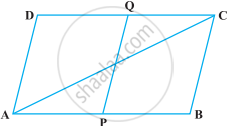Advertisements
Advertisements
प्रश्न
Two sticks each of length 5 cm are crossing each other such that they bisect each other. What shape is formed by joining their endpoints? Give reason.
उत्तर
Sticks can be taken as the diagonals of a quadrilateral.
Now, since they are bisecting each other, therefore the shape formed by joining their endpoints will be a parallelogram.
Hence, it may be a rectangle or a square depending on the angle between the sticks.
APPEARS IN
संबंधित प्रश्न
Diagonals of a parallelogram are perpendicular to each other. Is this statement true? Give reason for your answer.
Diagonals of a quadrilateral ABCD bisect each other. If ∠A = 35º, determine ∠B.
E and F are points on diagonal AC of a parallelogram ABCD such that AE = CF. Show that BFDE is a parallelogram.
Points P and Q have been taken on opposite sides AB and CD, respectively of a parallelogram ABCD such that AP = CQ (Figure). Show that AC and PQ bisect each other.

In a parallelogram ABCD, AB = 10 cm and AD = 6 cm. The bisector of ∠A meets DC in E. AE and BC produced meet at F. Find the length of CF.
In the following figure, AB || DE, AB = DE, AC || DF and AC = DF. Prove that BC || EF and BC = EF.

ABCD is a rectangle in which diagonal BD bisects ∠B. Show that ABCD is a square.
P is the mid-point of the side CD of a parallelogram ABCD. A line through C parallel to PA intersects AB at Q and DA produced at R. Prove that DA = AR and CQ = QR.
The point of intersection of diagonals of a quadrilateral divides one diagonal in the ratio 1:2. Can it be a parallelogram? Why or why not?
Two sticks each of length 7 cm are crossing each other such that they bisect each other at right angles. What shape is formed by joining their end points? Give reason.
